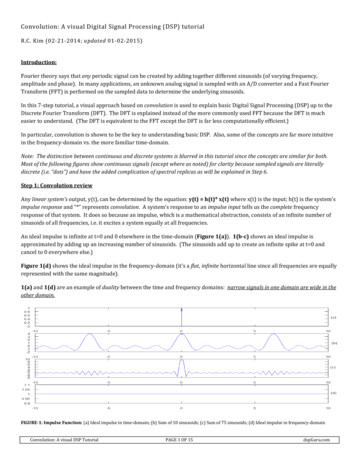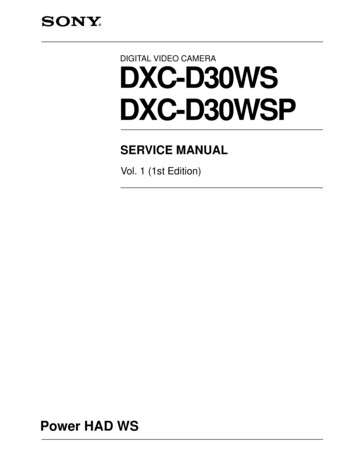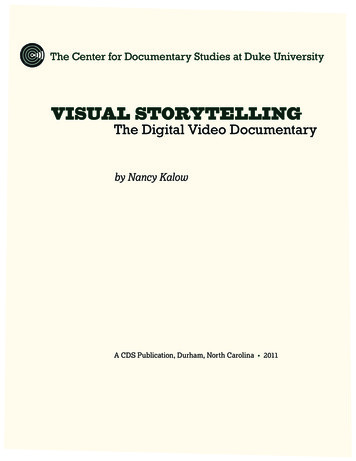
Transcription
The Center for Documentary Studies at Duke UniversityVISUAL STORYTELLINGThe Digital Video Documentaryby Nancy Kalow1VISUAL STORYTELLINGA CDS Publication, Durham, North Carolina 2011
Visual Storytelling: The Digital Video DocumentaryCopyright 2011 Nancy KalowAll video stills and photographs are copyright by the artists.Visual Storytelling is made available under a Creative CommonsAttribution-NonCommercial-ShareAlike 3.0 Unported sa/3.0Please use the following credit when sharing this work:Nancy Kalow’s Visual Storytelling: The Digital Video Documentaryis a publication of the Center for Documentary Studies at DukeUniversity. 2011.Designed by Bonnie CampbellA CDS BOOKThe Center for Documentary Studies at Duke UniversityP.O. Box 908021317 W. Pettigrew StreetDurham, North Carolina 27705Email: docstudies@duke.eduWebsite: http://documentarystudies.duke.eduVISUAL STORYTELLING2
CONTENTSINTRODUCTION 4Rise of the Digital Documentary 4The Documentary Approach? 5Closeness 6Showing Rather Than Telling 6Shooting to Edit 6CHAPTER ONEShooting 6Framing 7Shooting Do’s and Don’ts 8Camera Shots 9Close-up 9Extreme Close-up 9Medium Shot 9Wide Shot 10Establishing Shot 10Camera Movements 10Zoom 10Pan 10Tilt 11Tracking 11Crane or Jib 11Checklist of Standard Shots 11Interviewing Subjects:A Camera Checklist 12Troubleshooting Common Problems 13Choosing Engaging Storytelling overHigh-Tech Camera Features 15CHAPTER TWOListening 16Improving Your Listening Skills 18Recording Good Audio 20CHAPTER THREEFinding the Story 22Suggestions for Narrowing in onthe Story 23VISUAL STORYTELLINGCHAPTER 4Telling Someone Else’s Story 26The Ethics of Documenting Others 27Time 27Openness to Possibilities 28Transparent Realness 30Obtaining Permissions 31Sample Release Form 34CHAPTER 5Finishing and Sharing the Story 35Organizing Footage 35Selecting, Capturing, and SequencingFootage 36Characters 37Interviews 37Activity 37Humor 38Putting it all Together: A Review ofDocumentary Elements of Editing 383Observational Footage 38Transitions 38Narration 39Music 39Text 39Photographs and Other Still Images 40Super 8 and Other Historical MovingImages 40Screening Your Video 40And for Your Next Video . . . 41APPENDIXLinks and Resources 42ACKNOWLEDGMENTS 44
INTRODUCTIONVisual Storytelling: The Digital Video Documentary is for anyonewho wants to make a watchable short documentary with a consumer camcorder, digital SLR camera, or cell phone. My aim is toshow you the no-nonsense, inexpensive, and ethical approaches tocreating documentary video with these tools. Making low-budgetdocumentaries is particularly rewarding because you maintainindependence and control over the project. You, the filmmaker,get to decide what to research and how to shoot. You’re the onewho spends time with and learns the most from the participants inyour documentary. And you decide how to tell the story during theediting process. In the pages that follow, you’ll find technical guidance, fieldwork how-to’s, and practical advice from my ten years ofteaching low- and no-budget filmmaking.I began teaching documentary video after extensive immersionin documentary work in North Carolina, both as a folklorist making videos about local traditions and as a programmer watchinghundreds of films submitted each year for the Full Frame Documentary Film Festival. I came to be passionate about the democratization of documentary filmmaking and wanted to pass on whatI’d learned as a practitioner and viewer.Indeed, the documentary arts are flourishing in Durham andChapel Hill. A wide range of institutions and programs—includingthe Center for Documentary Studies at Duke University, the University of North Carolina’s Folklore program, and the Full FrameDocumentary Film Festival—engage the public in documentaryinquiry.Rise of the Digital DocumentaryToday’s digital documentaries rose out of a decades-long processof simplifying shooting and editing. Digital filmmaking has become much more accessible and personal as a result of the popularity of consumer camcorders. Documentary films, which hadbeen heavily scripted and shot with cumbersome film cameras,evolved with the arrival of directors like Richard Leacock, D. A.Pennebaker, and the Maysles Brothers. In the 1960s and ’70s, theyused compact and relatively lightweight 16mm film cameras, andsmaller crews. They filmed events observationally rather than following a preconceived script, and anticipated the practice of shoot-VISUAL STORYTELLING4
From Weather Diary I byGeorge Kuchar.From Sadobabies by NancyKalow.ing with high footage-to-final-running-time ratios. Craig Gilbert’stwelve episodes of An American Family (which was the precursorto MTV’s Real World and other reality TV series) and the filmsof Frederick Wiseman were similarly shot without scripts usingsmall crews, 16mm film, and many hours of footage taken overlong periods of time. Documentary became increasingly distinguishable from journalism by the filmmakers’ artistic ambitionsand the investment of time devoted to fieldwork.Ross McElwee’s first-person documentaries, such as his popular 1985 film Sherman’s March, presaged the boom in personalvideo making. McElwee shot the film with a 16mm camera whilerecording sound with a reel-to-reel tape recorder. Indeed, he was a“one-man crew” doing both camerawork and audio. The Dogme 95Manifesto, created by Danish directors Lars van Trier and ThomasVinterberg in 1995, advocated against added lighting and othernon-naturalistic techniques in feature films. Their ideas mesh perfectly with the ability of camcorders, digital SLRs, and cell phonesto record video in natural and low-light settings. The rise of extremely low-budget (or no-budget) video allowed personal expression to become almost wholly unrestrained, as in the videos ofGeorge Kuchar.Ethnographic documentaries also began to use low-budgetvideo to depict communities off the beaten track. Louis Hock’s TheMexican Tapes: A Chronicle of Life Outside the Law (1986) and my8mm video Sadobabies (1988) are two early examples. Camcordersand cell phones have also been used by activists, journalists, andcitizens, as well as issue-driven documentary filmmakers. Popularand revolutionary movements around the world are being documented with digital video.The Documentary ApproachI love the masterworks of nonfiction film, and find much to admirein a well-produced hour-long or feature-length documentary. Butthere are so many untold stories that would make great movies,and there isn’t enough production funding to pay for them. Small,inexpensive camcorders, digital SLR cameras, and cell phones allow the solo videomaker to get started on a short film without waiting to raise thousands of dollars. The Visual Storytelling approachleads to good technical quality and engaging storytelling by taking advantage of the inherent strengths of the camera, namelycloseness, showing rather than telling, and shooting to edit.VISUAL STORYTELLING5
Closeness suggests to the viewer that you have the consent andcollaboration of the person you are recording. An audience maynot be thinking about consent while watching the film, but theywill respond to and get a better feel for the characters if you shootin close proximity to them. Also, the sound and image quality arebetter when the camera is positioned near the subject; the camerapicks up detail better, the footage is less shaky, and the microphone records sound more clearly.Alonzo FelderShowing rather than telling means to make the documentaryThe camera picks up betterdetail when positioned nearthe subject.CHAPTER 1primarily visual. You can establish location, relationships, storytransitions, and other elements visually, and reduce explanatorytext or narration. Learn to shoot and use plenty of footage thatshows people doing things rather than talking about doing things.As François Truffaut said, “A filmmaker isn’t supposed to saythings; his job is to show them.”Shooting to edit means using your time on location carefully torecord all the material you will need in editing, because the situation in the field can’t be recreated later to fill in the gaps. Shootingto edit comes naturally with experience, and you can get good results from diligent advance planning combined with improvisingin the field.With your ideas for a documentary video and the guidance inVisual Storytelling, you’ll be able to shoot and edit a well-made andaudience-pleasing piece.SHOOTINGUsing a camcorder, DSLR, or cell phone leads to intimacy andimmediacy, which helps to draw an audience into your story andcharacters. A documentary film may appear to be a faithful recordof events and people, but no documentary is completely objective.The filmmaker makes the decisions, such as how to frame a shot,which subjects to use to develop a story, and what to leave in theedited video. The result is a uniquely personal document that issubjective and imaginative.Videographers learn from experience that a camera has itsown sight and hearing (see Chapter 2: Listening). A person cansee much more in a scene than the camera is able to record, so thefilmmaker will need to make decisions to create what his or heraudience should see. Filmmakers go through a process of discov-VISUAL STORYTELLING6
ering what works and what doesn’t work, and part of that processis training the senses to compensate for the camera’s limitations.The following pages cover technical advice on composition, framing, camera movements, and shooting in the field.FramingLEFT TO RIGHT: The frame forhigh definition (16 x 9 aspectratio) video; the frame for standard definition (4 x 3) video.Angie LeeThe first thing to keep in mind is the “rule of thirds” of motion picture composition. Think of the frame as divided into thirds, bothhorizontally and vertically.When you look through your viewfinder to frame a scene, tryto visualize the grid and put the most important features on theintersections of the lines. In other words, the middle of the frameis not the most visually interesting. Newscasters, for instance, arealways framed in the center of the television screen for a stable butdull visual image. A more dynamic framing sets objects or peopleon the intersections of the grid lines, as the two people are in theasymmetrical frame by Angie Lee.Two basic concepts in good videography are headroom andnoseroom. Headroom refers to the amount of space above a subject’s head. The shot is visually distracting if the subject is eithercrammed against the top of the frame or placed too low in it, withtoo much space above his or her head. Try to position the subject’seyes on the top line of the rule of thirds grid.Use the “rule of thirds” toframe subjects.LEFT TO RIGHT: Too muchNancy Kalowheadroom; better framing.Noseroom is also called “look space,” and it refers to composing a shot so that there is some space in front of the subject’s noseVISUAL STORYTELLING7
LEFT TO RIGHT: Too littleNancy Kalownoseroom; correctedframing.when he or she appears in partial or full profile. You don’t want theviewer to perceive the nose as hitting the side of the frame.Many camcorders and DSLRs have an autofocus feature,which you should turn off because the autofocus mechanism constantly searches for focus, ruining many shots with distractingblurry-sharp-blurry adjustments. To focus manually, zoom in allthe way on what you want to focus on, such as a person’s eyes,and adjust until the subject’s eyes are in sharp focus. Then zoomback out to your desired framing. Always use manual focus andcompose with the rule of thirds, with your subject to the left orright of center.Nancy KalowShooting Do’s and Don’tsTry letting your subject moveacross the frame withoutpanning the camera.VISUAL STORYTELLINGThe camera does not see as the eye sees, even though it recordsvisual information. Your eyes can naturally and effortlessly dartfrom place to place, follow the action, and focus in on the tellingdetail. You’ll notice an important limitation of the camera’s eyewhen you look at video footage in which the videographer or camera is moving too much. Footage is much more watchable whenthe camera is still and the subjects are moving. With the camera inhand, videographers are tempted to veer all around (“firehosing”)or zoom in and out, both of which render the shots hard to watchand hard to edit. Use a tripod to stabilize the camera, or train yourself to hold the camera still. Prevent firehosing to give your videoa more professional look. Any movements, such as zooms or pans,should serve to advance or deepen your story. Always rememberto settle on a shot for ten to fifteen seconds. If you shoot a lot of activity or a performance, position yourself close to the action evenif you feel that the tripod takes up a lot of space. Curiously, a videographer tends to become invisible—people become so used toseeing you and your camera that you really don’t interfere with theaction when you document from close in.Allow your subject to move beyond the edge of the frame withoutpanning the camera. Similarly, if a person walks through the scene,allow him to enter the frame and walk through it without a pan.8
If a person is walking away from you and the camera, let her getsmaller and smaller; resist the urge to use the zoom button. It mightseem counterintuitive not to always follow action with pans andzooms, but they are often more distracting rather than illuminating.Camera ShotsFilmmakers share a language of shots and camera moves. Manyfiction filmmakers plan their shots in advance, seeking emotionalresonance and story advancement through compositional choices.Documentary videographers may not be as rigid in pre-planningtheir shots, but they do respond to situations at hand with a toolkit of possibilities. Planning a documentary shoot means that youneed to be prepared to use several standard types of shots thatyou’ve practiced: close-ups, medium shots, and wide shots.Close-upA close-up positions a person or
Visual Storytelling, you’ll be able to shoot and edit a well-made and audience-pleasing piece. SHOOTING Using a camcorder, DSLR, or cell phone leads to intimacy and immediacy, which helps to draw an audience into your story and characters. A documentary film may appear to be a faithful record of events and people, but no documentary is completely objective. The filmmaker makes the decisions .
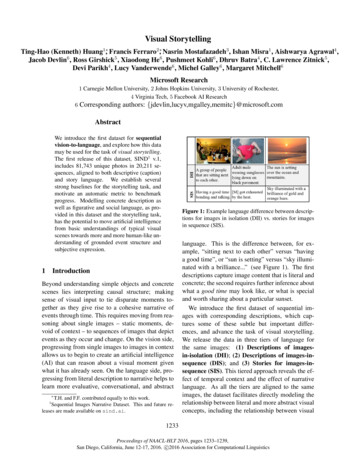

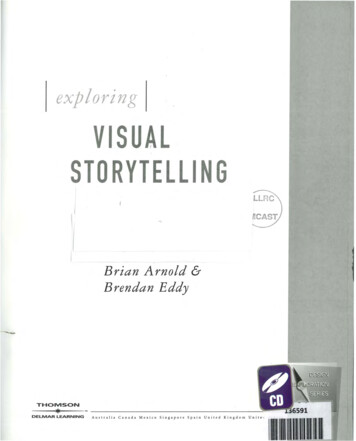
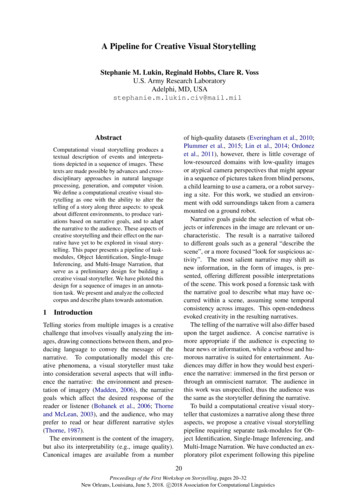

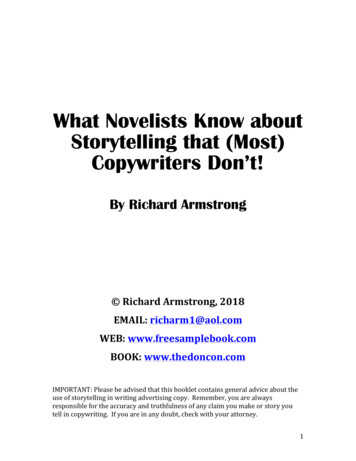
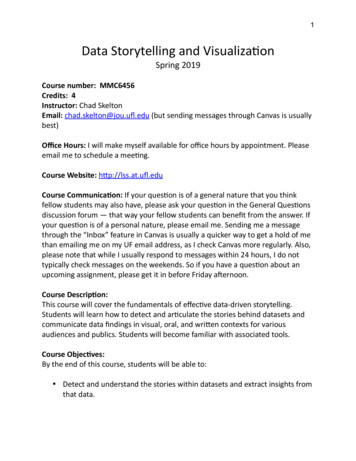


![[digital] Visual Effects and Compositing](/img/1/9780321984388.jpg)
